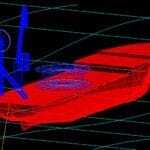Stability of Ships – Hydrostatic and Hydrodynamic

The September, 2016 issue of The Naval Architect (RINA) has an interesting article on ship stability that focuses on intact hydrostatics and the uncertainties in predicting this as related to the uncertainty in predicting the ship weight center. The paper can be viewed here:
The RINA article references earlier work by the authors:
I.WOODWARD, M.D., van RIJSBERGEN, M., HUTCHINSON,
K.W. and SCOTT, A.L. ‘Uncertainty Analysis Procedure for the Inclining Experiment; Ocean Engineering, Elsevier, Amsterdam, The Netherlands, Volume 114, I March 2016, Pages 79 to 86. ISSN: 0029-8018 (click downoad link below)
Uncertaintyanalysisprocedurefortheshipincliningexperiment
It is interesting that one example is the Sewol Ferry. STA has been providing Marine Salvage Dynamics engineering services to the Salvor, Shanghai Salvage Company.
One of the biggest difficulties has been assessing the vessel weight, including cargo. There has been much uncertainty about this issue.
In the dynamic lift analysis, hydrodynamic effects are extremely important. The mass of the sunken vessel and cargo is less than 10,000 tons, but trapped water mass and added hydrodynamic mass are over 120,000 tons as the wreck is accelerated by small crane motions.
MDL Hydro has been used by STA, including comparisons with WAMIT, to assess diffraction forces and added hydrodynamic mass terms. OrcaFlex has been used to calculate dynamic sling tensions in the time domain.
It has not been part of STA’s work to determine reasons for the Sewol capsize. STA has been working hard to keep the salvor from further damaging the accommodation areas of the wreck where the remains of nine victims are thought to be. This has involved seabed geotechnical assessment and ground reaction calculations possibly without precedent.
The salvage involves the 12,000 ton ZPMC crane for the final side lifts in one piece.
View list of STA software.


